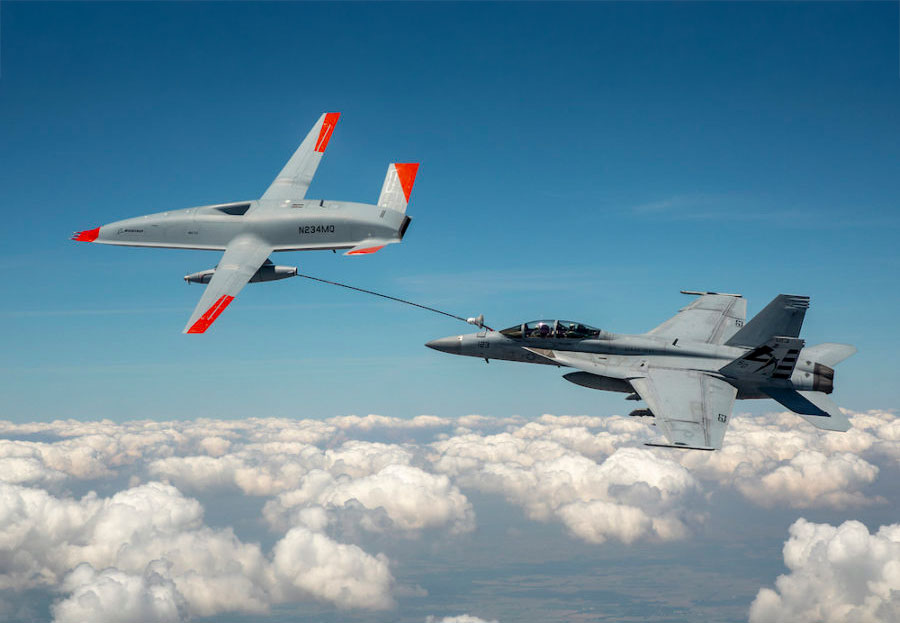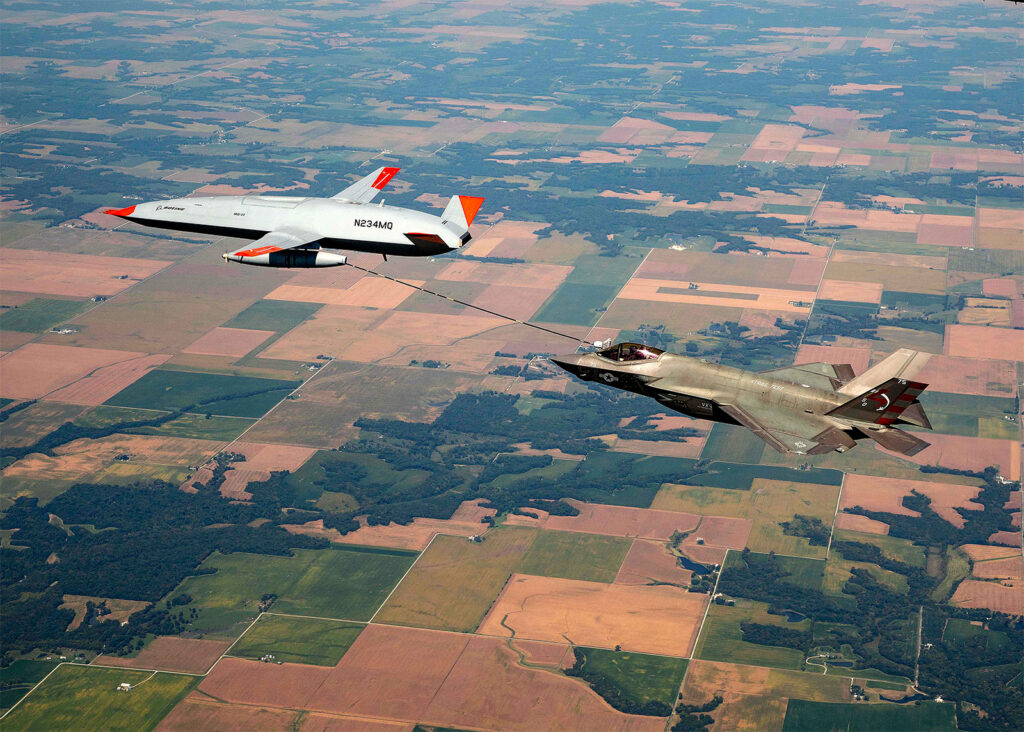The Boeing MQ-25 Stingray is a carrier-based unmanned aerial refueling aircraft designed to extend the operational range of U.S. Navy combat jets.
The Boeing MQ-25 Stingray is an unmanned aerial refueling aircraft developed for the U.S. Navy to enhance the operational range of carrier-based aircraft. Powered by a Rolls-Royce AE 3007N turbofan engine delivering over 10,000 pounds (4,536 kilograms) of thrust, the MQ-25 features a wingspan of 75 feet (22.86 meters) and a length of 51 feet (15.54 meters). It is designed to deliver up to 15,000 pounds (6,800 kilograms) of fuel to receiver aircraft at a range of 500 nautical miles (926 kilometers). The aircraft’s design includes a V-tail configuration and a flush inlet to reduce radar cross-section, enhancing its stealth capabilities. The MQ-25 first flew on September 19, 2019, and is set to become the world’s first operational carrier-based unmanned aircraft, providing critical aerial refueling support to the Carrier Air Wing.
History of the Development of the Boeing MQ-25 Stingray
In the mid-2000s, the U.S. Navy recognized the strategic necessity of integrating unmanned systems into carrier operations to enhance surveillance and strike capabilities. This realization led to the initiation of the Unmanned Carrier-Launched Airborne Surveillance and Strike (UCLASS) program in 2006, aiming to develop a stealthy, carrier-based unmanned aircraft capable of intelligence, surveillance, reconnaissance (ISR), and precision strike missions.
However, by 2012, shifting defense priorities and budget constraints prompted a reevaluation of the program’s objectives. The focus transitioned from a stealthy strike platform to an ISR-oriented aircraft designed for counterterrorism missions in low-intensity conflict environments. This shift aimed to expedite development and deployment timelines to address immediate operational needs.
Further assessment of carrier air wing operations revealed a critical gap in organic aerial refueling capabilities. Carrier-based strike fighters, such as the F/A-18E/F Super Hornet, were frequently tasked with refueling missions, reducing their availability for combat operations. To mitigate this issue and extend the operational range of carrier-based aircraft, the Navy restructured the UCLASS program into the Carrier-Based Aerial-Refueling System (CBARS) program on February 1, 2016. The primary objective shifted to developing an unmanned aerial refueling platform, with secondary ISR capabilities.
In July 2016, the program was officially designated as the MQ-25A Stingray. The “M” prefix denotes a multi-mission platform, while “Q” signifies an unmanned aircraft system. The name “Stingray” reflects the aircraft’s sleek design and maritime operational environment.
The Navy released the final Request for Proposals (RFP) in October 2017, inviting bids from major defense contractors. Boeing, Lockheed Martin, General Atomics, and Northrop Grumman submitted proposals. Notably, Northrop Grumman withdrew from the competition in October 2017, citing an inability to meet the program’s requirements within the specified terms. On August 30, 2018, the U.S. Navy awarded Boeing an $805 million contract to develop the MQ-25A, with an initial order of four aircraft slated for delivery by August 2024.
Boeing’s selection was influenced by its prior experience in unmanned systems and a design that met the Navy’s requirements for a carrier-based refueling drone. The company’s approach leveraged lessons learned from previous unmanned aerial vehicle (UAV) projects, including the Phantom Ray demonstrator.
The MQ-25 program achieved a significant milestone on September 19, 2019, when the first test aircraft, known as T-1 or “Tail 1,” completed its maiden flight. This flight validated the aircraft’s basic flight capabilities and set the stage for subsequent testing phases. In December 2020, Boeing released footage of the MQ-25 T-1 conducting its first flight with a Cobham aerial refueling store (ARS) mounted, demonstrating the aircraft’s refueling configuration.
On June 4, 2021, the MQ-25 T-1 made aviation history by successfully refueling an F/A-18F Super Hornet in flight. This milestone marked the first-ever aerial refueling operation conducted by an unmanned aircraft. The mission lasted approximately 4.5 hours, during which the MQ-25 transferred 325 pounds (147 kilograms) of fuel to the receiver aircraft. Subsequent refueling tests were conducted with other carrier-based platforms, including the E-2D Hawkeye and the F-35C Lightning II, further validating the MQ-25’s capabilities.
The development of the MQ-25 Stingray addresses the Navy’s strategic imperative to enhance the range and flexibility of its carrier air wings. By assuming the aerial refueling role, the MQ-25 alleviates the burden on manned strike fighters, allowing them to focus on combat missions. This evolution reflects the broader trend of integrating unmanned systems into complex military operations to improve efficiency and effectiveness.

Design of the Boeing MQ-25 Stingray
The design of the Boeing MQ-25 Stingray integrates advanced aerodynamics, stealth features, and robust engineering to fulfill its role as a carrier-based unmanned aerial refueling aircraft. The aircraft’s structural and functional attributes are meticulously crafted to meet the rigorous demands of naval operations.
The MQ-25 Stingray features a blended-wing-body design optimized for aerodynamic efficiency and carrier-based operations. It measures 51 feet (15.54 meters) in length, with a wingspan of 75 feet (22.86 meters) when fully extended. The wings fold to minimize deck footprint when stored on an aircraft carrier. The airframe is composed of advanced composite materials to reduce weight while maintaining structural integrity under high-stress conditions.
The aircraft is equipped with a V-tail configuration, which enhances stability and control while reducing radar cross-section. The flush-mounted engine inlet is designed to minimize radar signature, improving survivability in contested environments. Unlike previous unmanned carrier-based aircraft concepts, the MQ-25 does not feature a stealthy faceted fuselage but instead prioritizes low observability through shaping and materials.
The MQ-25 operates with automated carrier takeoff and landing systems, integrating into the existing Joint Precision Approach and Landing System (JPALS) used by U.S. Navy aircraft. It employs an electrically actuated landing gear system, capable of withstanding the high-impact landings associated with carrier operations. The aircraft is fitted with an arrestor hook for recovery aboard carriers.
A critical design feature is its aerial refueling capability. The MQ-25 is equipped with a Cobham 31-301 refueling pod, which extends a hose-and-drogue system to refuel compatible aircraft in-flight. It can carry up to 15,000 pounds (6,800 kilograms) of fuel, providing operational range extension for aircraft such as the F/A-18E/F Super Hornet, EA-18G Growler, and F-35C Lightning II.
The mission control system is operated remotely from a ground station, likely integrated within the carrier’s existing command and control structure. The MQ-25 does not require a dedicated control aircraft; instead, it can be directed from carrier-based operators using satellite and line-of-sight communications.
Advantages and Drawbacks
One of the MQ-25’s key advantages is its ability to extend the operational range of carrier-based strike aircraft. By providing mid-air refueling at 500 nautical miles (926 kilometers) from the carrier, it significantly enhances the strike capability of the Carrier Air Wing. This reduces reliance on manned aerial refueling tankers, such as the F/A-18 Super Hornet, which has traditionally performed buddy refueling at the cost of its strike role.
However, the MQ-25 is not designed for multi-role combat operations. It lacks the stealth and payload capacity of earlier UCLASS concepts, meaning it does not contribute to strike missions beyond its refueling role. Additionally, its dependency on remote operation raises concerns regarding electronic warfare vulnerabilities, as adversaries may attempt to jam or disrupt communications.
Performance of the Boeing MQ-25 Stingray
The MQ-25 is powered by a Rolls-Royce AE 3007N turbofan engine, a derivative of the AE 3007 series used in various aircraft, including the MQ-4C Triton and RQ-4 Global Hawk. The engine delivers 10,000 pounds (4,536 kilograms) of thrust, providing the necessary power for carrier operations and aerial refueling.
Speed and Altitude
The MQ-25 has a maximum speed of approximately 466 knots (863 km/h, Mach 0.7). While slower than manned fighter aircraft, this speed is sufficient for its refueling mission. The aircraft operates at a service ceiling of 40,000 feet (12,192 meters), allowing it to support various mission profiles.
Range and Fuel Capacity
One of the most critical performance factors of the MQ-25 is its range and fuel transfer capacity:
- Ferry range: 2,500 nautical miles (4,630 kilometers)
- Operational refueling range: 500 nautical miles (926 kilometers)
- Maximum fuel offload: 15,000 pounds (6,800 kilograms)
This capability allows it to provide extended mission endurance for carrier strike groups.
Comparative Analysis
When compared to manned refueling aircraft, the MQ-25 presents advantages in endurance and cost-effectiveness. Unlike a KC-130J Hercules or KC-135 Stratotanker, which require multiple crew members and high operational costs, the MQ-25 operates autonomously. Its compact size and ability to launch from aircraft carriers provide a strategic advantage in maritime operations.
In contrast, dedicated tanker aircraft like the Boeing KC-46 Pegasus offer greater fuel capacity and higher-speed refueling, but they require land-based operations. The MQ-25 fills a capability gap by enabling carrier-based refueling, ensuring a continuous presence in contested environments without reliance on shore-based infrastructure.
Variants of the Boeing MQ-25 Stingray
Currently, there are no significant variants of the MQ-25, as the aircraft is in early production. However, there are minor configuration differences:
- MQ-25 T-1 (Test Aircraft)
- Role: Prototype for testing flight performance and refueling capabilities
- First flight: September 19, 2019
- Refueling trials conducted with: F/A-18F, E-2D, F-35C
- MQ-25A (Production Model)
- Role: Operational refueling aircraft
- Design improvements: Structural modifications for carrier operations, updated software integration
- Planned operational capability: 2025
The Navy has not announced additional configurations, but future versions may integrate expanded ISR capabilities or defensive countermeasures.

Military Missions of the Boeing MQ-25 Stingray
Aerial Refueling
The primary mission of the MQ-25 is to extend the range of carrier-based aircraft through aerial refueling. This allows F/A-18 Super Hornets, EA-18G Growlers, and F-35Cs to operate further from the carrier without requiring dedicated tanker support.
Surveillance and Reconnaissance
Although not the primary focus, the MQ-25 has limited ISR capabilities. Equipped with electro-optical/infrared (EO/IR) sensors, it can perform maritime surveillance and target tracking. Future enhancements may integrate synthetic aperture radar (SAR) for all-weather reconnaissance.
Combat Support
While unarmed, the MQ-25 contributes to combat operations by freeing up strike aircraft from refueling duties. This increases the number of fighters available for offensive missions.
Deployment and Operators
The MQ-25 is being developed exclusively for the U.S. Navy. As of 2024, there are no foreign sales, though allied nations may express interest in a carrier-based refueling drone. The first operational deployment is expected by 2026, integrated within U.S. Navy carrier strike groups.
As the U.S. Navy transitions towards increased use of unmanned systems, the MQ-25 sets a precedent for future autonomous carrier-based aircraft. With successful refueling trials completed, it remains on track for operational deployment in 2026, reinforcing U.S. naval power projection across global maritime theaters.
Back to the Drones, UAVs, UCAVs page